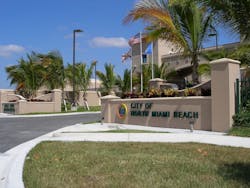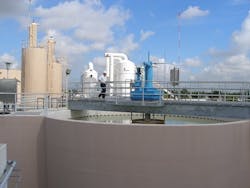Split the Uprights
Bob Crossen is managing editor for WWD. Crossen can be reached at [email protected]
At the end of December 2017, North Miami Beach (NMB) Water broke ground on an $11-million investment plan to upgrade its Norwood Water Treatment Plant.
Originally built in the 1940s, the plant primarily was built for lime softening to address the type of water found in the Florida communities it serves. The plant mostly got its water from the Miami-Dade Water and Sewer Department, but an expansion after the facility was purchased by NMB Water in 1957 established 12 Biscayne aquifer wells, seven of which are located on site. As such, it expanded from 16 million gal per day (mgd) to 27 mgd.
In 2008, the plant got further advancements in technology with reverse osmosis (RO) and nanofiltration membranes. This new $11-million plan is seen as a “transformation” of the plant that includes phases to assess facility conditions and develop a priority list of items to complete based on those conditions. Although the list now looms large—it includes 27 sub-projects—the primary focus of the updates are generators and electrical work.
Remotely actuated valves will cut down on operator time spent dispatching workers to address equipment needs.
Split Treatment
Twenty wells—some Floridian, others Biscayne—provide the source water for the Norwood Water Plant. Depending on where the water originates, it will be pumped through specific processes to treat it. For instance, the water from the Biscayne aquifer flows first through the lime softening plant. The Floridian aquifer water, on the other hand, is brackish and enters the membrane plant for treatment instead.
“The RO system is primarily for treating the Floridian wells, and we send some of the Biscayne water through the nanofiltration,” said Jeff Thompson, director of NMB Water. “The main point of the treatment and why the city made that move is because nanofiltration provides the highest quality water that you can provide, but then it being blended back with the lime softening water, that allows you to also put in some of the minerals. With RO, you only get H, 2 and O. Nothing comes through that membrane.”
To reach optimal quality and taste, Thompson said the plant blends the water that passes though RO with the water from the lime softening plant. Some of it is stored on site, with much of it then being pushed through the distribution system to the five municipalities the Norwood Water Plant serves.
“We do definitely blend everything back together before we send it out,” Thompson said. “The way we look at it, we have the raw water come in, have a split treatment [for Biscayne aquifer water] that goes to lime softening, goes to nanofiltration—those are the two primary processes—and then those are re-blended, chlorinated and exit out of the system.”
The plant uses free chlorine for disinfection, followed by ammonia treatment, and the chloramines cap the disinfection process to solve any residual issues and ensure the water is safe for consumption.
Remotely actuated valves will cut down on operator time spent dispatching workers to address equipment needs.
Improvements for Operators
For plant operators, the $11 million in upgrades include quality of life improvements that will make their work more efficient and safer to conduct. Among the updates is a new SCADA system with remote monitoring options.
“For a lot of our systems, we had the data, but we didn’t have the ability to actuate valves remotely, so we wanted to add some of that functionality, instrumentation and control systems,” Thompson said.
If an adjustment needed to be made based on the data provided in the control room, the operator would have to dispatch a worker by radio to attend to the piece of equipment in person. By adding a control function, dispatching workers would only be needed in the most extreme scenarios.
In addition to providing controls where operators can put remote monitoring information to use, other equipment within the train was replaced to cut down on maintenance costs and time spent getting a desired functionality or result from the machine.
“When you have to babysit a piece of equipment that has been very temperamental, that’s frequently going down and having to be worked on, and then replacing it with a piece of equipment that doesn’t need to have that level of effort, that’s a real big benefit for the operators,” Thompson said. The efforts previously used to keep those machines running can be reallocated to other goals for the plant, such as improving water aesthetics for the end user.
Also among the changes benefiting workers were peripheral building upgrades and elevated walkways to improve the safety of NMB Water employees on site.


